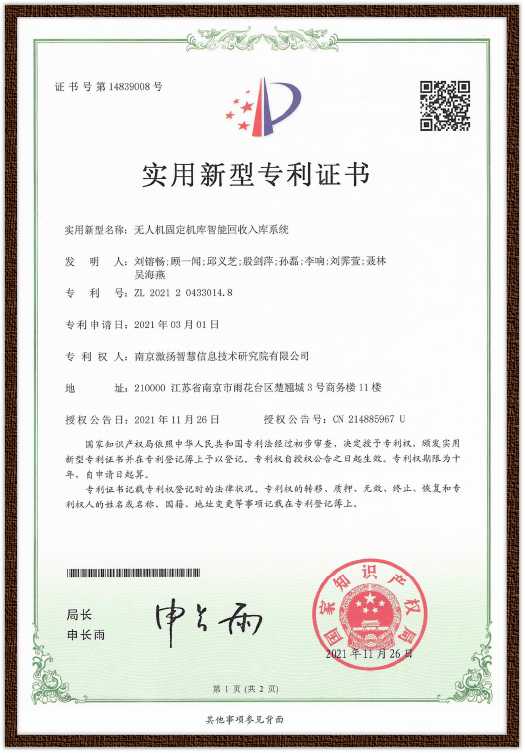Smart Bird's Nest
Long-range, Fully Automated, Unmanned Airport with Smart Process Integration
Smart Bird's Nest - the world's first fully automated unmanned airport with smart process integration.
As a critical component of the drone system, it adopts innovative designs such as "one cabin, three
drones" and "one cabin, multi-purpose," enabling continuous 24/7 daily inspections and dynamic
monitoring within a 420-kilometer inspection radius. It can carry various types of drones to meet the
needs of multiple industries.
Technical Characteristics
Our company has successively applied for more than 20 patents and software Copyrights around
Jingtianwei, forming a strict intellectual property protection pool, and the intelligent recovery
storage system of UAV fixed hangar has been authorized.

【Automatic Driving】
Fully automatic driving completely replaces manual control, sets flight tasks in the
flight control platform, and the UAV automatically takes off from the airport,
performs flight tasks according to the set route, and automatically returns to the
course and lands accurately.
【Real-time Response】
The airport is connected to the ground command center, and the high-definition
images and video information generated by the drone can be synchronously transmitted
back to the ground, providing a basis for the construction of digital China, and
responding in real time in emergencies.
【Highly Collaborative】
Unified management and scheduling of multiple unmanned airports, forming a smart
perception network covering the entire city's low altitude, reducing management
costs, improving management efficiency and data sharing capabilities.
【Intelligent Analysis】
The collected data are analyzed and processed in real time to improve the
convenience and timeliness of data utilization and promote the establishment of
digital China construction standard database.
【Unattended】
Support automatic operation and maintenance, automatic charging and other operations
of the UAV, to ensure that the UAV is fully automatic flight in the unmanned state,
to meet the work needs of 7*24 hours standby.
Spanning Across The Heavens And Earth
Sea, Land And Air Integrated Field Automatic Data Acquisition And Inspection Program
 Cross-region global low-altitude intelligent perception,
digital remote control management
Cross-region global low-altitude intelligent perception,
digital remote control management
It can realize the joint scheduling, management and automatic collection, sampling, analysis and
utilization of low-altitude space data of tens of thousands of UAVs in thousands of unmanned airports in
a city, a province, or even a country.
 Flight control platform: Controls the operation of
multiple fully automated unmanned airfields
Flight control platform: Controls the operation of
multiple fully automated unmanned airfields
Control the operation of multiple automatic unmanned airports, and unified dispatch of drones at
each airport. The airport is connected to the ground through the flight control platform, and the
high-definition images and video information generated by the drone can be synchronously transmitted
back to the ground, forming space-time big data, and providing massive data support for the
construction of new smart cities and digital villages.
 Intelligent bird's Nest field data automatic acquisition
and spatial geographic control system
Intelligent bird's Nest field data automatic acquisition
and spatial geographic control system
The system is composed of four major parts: basic platform, data center, application platform and
display platform, which realizes the collection and utilization of the whole time and all elements, and
forms a digital China standardized database to comprehensively improve the governance and service level
of urban and rural areas.
Equipped with drones
JI YANG 1
The unmanned aerial vehicle adopts an original patent technology of retractable rotor to achieve
vertical take-off and landing, with the capability of carrying heavy loads, long endurance, and vertical
take-off and landing at an altitude of 5000 meters on high plateaus. It is versatile in terms of
payload, being able to carry visible light cameras, oblique photography cameras, multispectral cameras,
dual-light gimbals, and laser radar. The maximum vertical lifting capacity can reach 10 kilograms, with
a maximum endurance of over 4.5 hours, and it can simultaneously carry out operations with multiple
payloads.
JI YANG 2
The composite aerodynamic layout combines a quadcopter with a flying wing, integrating the vertical
takeoff and landing capability of the rotorcraft with the long-range advantages of the fixed-wing
aircraft. It supports the installation of a full-frame mirrorless camera, a full-frame five-lens camera,
and a professional aerial survey camera. Utilizing all-electric propulsion, the high-efficiency
optimized avionics system achieves an extended endurance of up to 120 minutes.














 Take the lead in the industry to propose automatic
field data acquisition and spatial geographic control scheme
Take the lead in the industry to propose automatic
field data acquisition and spatial geographic control scheme

 The world is the first to realize the "Digital China"
cross-departmental and cross-industry automatic field data collection
The world is the first to realize the "Digital China"
cross-departmental and cross-industry automatic field data collection



 Cross-region global low-altitude intelligent perception,
digital remote control management
Cross-region global low-altitude intelligent perception,
digital remote control management

 Flight control platform: Controls the operation of
multiple fully automated unmanned airfields
Flight control platform: Controls the operation of
multiple fully automated unmanned airfields

 Intelligent bird's Nest field data automatic acquisition
and spatial geographic control system
Intelligent bird's Nest field data automatic acquisition
and spatial geographic control system








